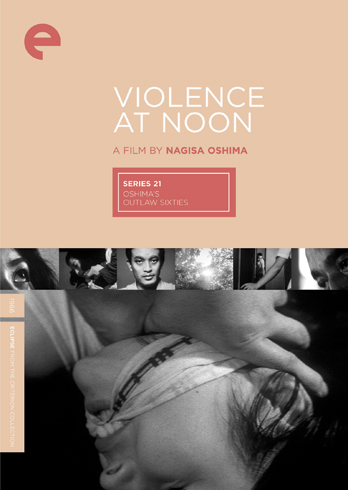Going into Nagisa Oshima’s latest Criterion outing, a collection of his 1960’s releases in the form of an Eclipse box set known as Oshima’s Outlaw Sixties, I couldn’t help but think that my high expectations, would most likely be shot down.
As much as I enjoy Oshima’s latter works, like In The Realm Of The Senses, Oshima has been known as the Godard of Japan, leaving me to think that this would be a life altering box set experience, like none other.
That said, now having actually seen the rather expansive collection of films, I can honestly say that this is not only a must own for any cinephile, it’s also an eye opening set of politically motivated, violent, and sexually charged pieces of cinema that many people have not had the joy of laying eyes on.
The collection opens with Oshima’s 1965 film, Pleasures Of The Flesh, a take on the famous novel, Pleasures Inside The Coffin. Pleasures follows a man, Atsushi, who is being blackmailed by a businessman who simply asks him to guard a briefcase holding 30 million yen. Realizing that he would be killed after the man’s jail sentence is up, he decides to go out and spend the money however he so feels.
Flesh opens with a voice-over, describing what has taken place, leading up to the film. We find Atsushi with the cash, and being depressed after his former pupil wed someone else, he decides to ask a prostitute to live with him for 1 million yen a month. The film is based off a screenplay written by Oshima, and features the same type of sexual energy, hand in hand with brutal and honest violence, that made Oshima become known as the auteur that he truly is. What is known as part of the ‘pink’ genre (soft-core sexploitation), that almost seems like a slight for this rather superb independent project. It’s far more politically charged than his latter work, taking a deep look at what became of Japan’s economy after WWII, and instead of using sex to excite the viewer, he uses it to show just what happens to a man who gives himself completely over to the vice that we all know as excess. It’s a visually striking film, with much of the story coming in exposition, but it’s also quite economical. Oshima doesn’t seem to be a filmmaker to waist prose. Every word is given time to breath, making this easily one of the best films of the set.
Flesh is followed by yet another sexually violent piece of cinema, known as the 1966 film, Violence At Noon. However, that’s about where any of the comparison’s stop. Whereas Pleasures was a film consisting of very few takes, featuring longer shots showing just how skilled Oshima was behind the camera, he flips the switch for Violence, giving us a film featuring nearly 2,000 individual shots, making this the most kinetic and surreal film in the collection. This also marks the first pairing of Oshima and actor Kei Sato (who sadly passed earlier this year), who would later work on both Sing A Song Of Sex and Three Resurrected Drunkards, as well as Violence
It follows two women, a young maid who has fallen victim to a serial rapist and killer, and the man’s wife, who we follow throughout the 98 minute film. It’s as much a dark character study of a man completely lost to madness and sexual violence, as it is about two women who for some reason cannot give up their love for this evil man. Violence sounds like an everyday melodrama, but the film is not only superbly acted, but is also darkly convincing. These performances are just as surreal and kinetic as each frame lensed by Oshima, and his editor Keiichi Uraoka make this film not only an interesting look at disillusionment with the political hierarchy of post-war Japan, but also the sets most striking visual feast. It is hard to really dig into, as the film’s nonlinear story is stark and could be confusing for some, but if you are willing to give yourself over to it, and if you are willing to pay close attention, this may be the box sets most interesting addition.
The first two films of this set also attempt to deal with something that seems to be a theme running through all of Oshima’s 1960’s releases, the idea of how people change after coming to terms with death. In both Pleasure and Violence, our leads have not only come to terms with the fact that their deaths are imminent, but that they are actually alright with that, and in the case of Violence, even wish to die. Oshima seems infatuated with this idea, often coming to the point that we as humans cannot truly live until we have stared death in the face, and have smiled back at it. It’s an interesting theme that while not touched on directly in his latter works, is something that is definitely there in these first few films.
Next, there is Oshima’s ’67 release, Sing A Song Of Sex. The film follows four sexually charged high school students as they prepare to take their entrance exams. They meet up with a teacher, who after a drunken evening, is found dead. This death launches us into a film that is far more freeform than any of his previous films, even the narratively off putting Violence. The four sing songs, obsess over a woman they met while taking a test, and even fantasize of raping a teacher in front of a class. Song is a film that ultimately works if you allow yourself to be given over to its rather absurd and anarchic tale of political disgust and angst, but it’s also one that isn’t easy to do that for. It’s one of Oshima’s more difficult films to watch, that while engaging, doesn’t necessarily say anything new or more interesting than what you see in any of the prior films, or really any of the latter. The performances are great, particularly a turn from pop star Ichiro Araki, and Oshima is giving us his best Kubrick with sexually violent fantasies and shots framed looking directly into the face of our leads as they give us these explicit dreams, but doesn’t give us the same narrative weight that the aforementioned auteur is known for.
Following that up is the 1968 release, Japanese Summer: Double Suicide. The film follows a collective of anarchists who become trapped in an underground hideaway. This is the most obscure and rare addition to the set, and yet happens to be one of Oshima’s most interesting. You have a collection of not only characters, but also themes that Oshima made famous. A young female looking for anyone to feed her sexual hunger; violent high school student with an affinity for gangster pictures, and an older gentlemen who wishes to be killed all fill Oshima’s take on a story similar to that of the Jean Paul Sartre play, No Exit. As is normal with the latter three Oshima films in this set, Suicide is completely an absurd piece, but it also is not truly a superb experience. This is definitely not one for those looking to jump right into the works of Oshima, as it will really turn a lot of viewers off of the filmmaker. That said, it is an interesting story, and it is of course a rather visually impressive film, but it shows that Oshima seemed to be losing a bit of steam as the years went on.
Finally, we have Oshima’s 1968 film, Three Resurrected Drunkards. This is Oshima both at his most politically boisterous, as well as his most over the top and cartoonish. The film follows a trio of friends who after going for a swim, find that their clothes have been switched out with those of Korean immigrants trying to escape the war. This is Oshima coming guns a blazing against the Vietnam War and the racism he saw during that time period, and while often drawing comparisons to the great Richard Lester film, A Hard Days Night, is neither as visually fun, nor as interestingly madcap as that classic Beatles picture. The comedy that the film finds makes this one film that isn’t nearly as harshly critical as his earlier works, making it much less of a commentary and much more of a live action Looney Tunes cartoon, or something like a Japanese Benny Hill episode. The narrative style is interesting, and of course it’s visually something to love, but the film is easily Oshima’s weakest, and while it may be the one that may be the most innocuous and easy to watch, it is definitely a minor work in the rather illustrious career of Nagisa Oshima.
Overall, while there are definitely problems with many of the films in this collection, particularly the latter two, the prior three, particularly the first two films, are easily some of the best cinematic outings of the era, and really continue to hold up. He may not be as well known as the legendary French auteur, Godard, but the kinetic visual style and equally energetic concepts behind his films, make Oshima one filmmaker that the world desperately needs to get back in touch with. We’d be a better place for it.
Images Courtesy Of The Criterion Collection:
Often called the Godard of the East, Japanese director Nagisa Oshima was one of the most provocative film artists of the twentieth century, and his works challenged and shocked the cinematic world for decades. Following his rise to prominence at Shochiku, Oshima struck out to form his own production company, Sozosha, in 1961. That move ushered in the prolific period of his career that gave birth to the five films collected here. Unsurprisingly, this studio renegade was fascinated by stories of outsiders’”serial killers, rabid hedonists, and stowaway misfits are just some of the social castoffs you’ll meet in these audacious, cerebral entries in the New Wave surge that made Japan a hub of truly daredevil moviemaking.
Available on May 18th, 2010 on DVD, the Collector’s set includes:
Pleasures of the Flesh
1965
A corrupt businessman blackmails a lovelorn murderer, Atsushi, into watching over his suitcase full of embezzled cash while he serves a jail sentence. Rather than wait for the man to retrieve his money, however, Atsushi decides to spend it all in one libidinous rush.
Violence at Noon
1966
Containing more than two thousand cuts and a wealth of inventive widescreen compositions, this coolly fragmented character study is a mesmerizing investigation of criminality and social decay.
Sing a Song of Sex
1967
Four sexually hungry high school students prepare for their university entrance exams in Oshima’s hypnotic, free-form depiction of generational political apathy, featuring stunning color cinematography.
Japanese Summer: Double Suicide
1967
A sex-obsessed young woman, a suicidal young man she meets on the street, a gun-crazy wannabe gangster’”these are just three of the irrational, oddball anarchists trapped in an underground hideaway in Oshima’s devilish, absurdist film.
Three Resurrected Drunkards
1968
A trio of bumbling young men frolic at the beach. While they swim, their clothes are stolen and replaced with new outfits. Having donned these, they are mistaken for undocumented Koreans and end up on the run from comically outraged authorities.











![Bergman Island (The Criterion Collection) [Blu-ray]](https://criterioncast.com/wp-content/uploads/2022/11/bergman-island-the-criterion-collection-blu-ray-400x496.jpg)
![This Is Not a Burial, It’s a Resurrection (The Criterion Collection) [Blu-ray]](https://criterioncast.com/wp-content/uploads/2022/11/this-is-not-a-burial-its-a-resurrection-the-criterion-collection-blu-ray-400x496.jpg)
![Lars von Trier's Europe Trilogy (The Criterion Collection) [The Element of Crime/Epidemic/Europa] [Blu-ray]](https://criterioncast.com/wp-content/uploads/2022/11/lars-von-triers-europe-trilogy-the-criterion-collection-the-element-of-400x496.jpg)
![Imitation of Life (The Criterion Collection) [Blu-ray]](https://criterioncast.com/wp-content/uploads/2022/11/imitation-of-life-the-criterion-collection-blu-ray-400x496.jpg)
![The Adventures of Baron Munchausen (The Criterion Collection) [4K UHD]](https://criterioncast.com/wp-content/uploads/2022/11/the-adventures-of-baron-munchausen-the-criterion-collection-4k-uhd-400x496.jpg)
![Cooley High [Criterion Collection] [Blu-ray] [1975]](https://criterioncast.com/wp-content/uploads/2022/11/cooley-high-criterion-collection-blu-ray-1975-400x496.jpg)